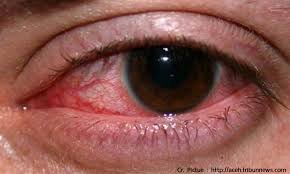 Last month, the American Academy of Allergy, Asthma and Immunology held its Annual Meeting…. virtually. Among the lectures I attended virtually was a series about eye allergies, which are reported in a 2016 article of Current Opinions Allergy Clinical Immunology to occur in 64% of those who have nasal/sinus allergic symptoms. Although I wrote about this topic in March 2019, it may be useful in March 2021 to go over some other information I heard that those who are affected should also know.
Last month, the American Academy of Allergy, Asthma and Immunology held its Annual Meeting…. virtually. Among the lectures I attended virtually was a series about eye allergies, which are reported in a 2016 article of Current Opinions Allergy Clinical Immunology to occur in 64% of those who have nasal/sinus allergic symptoms. Although I wrote about this topic in March 2019, it may be useful in March 2021 to go over some other information I heard that those who are affected should also know.
Eye allergies are called medically as allergic conjunctivitis (AC). The symptoms of AC can be remembered in the acronym ‘TIRED’ These are tearing, itching, redness and edema (i.e. swelling). The itching can occasionally be felt as a burning sensation. These symptoms typically involve both eyes when the cause is an outdoor allergen, e.g. tree pollen in spring.
When the conjunctivitis is severe, the cornea is affected and any of these symptoms can occur: pus from the eye; pain in the eye; sensitivity to light; blurring or double vision or loss of a portion of the field of vision. Wearing contact lenses or having sutures in the eye at the same time is especially alarming. Pain and sensitivity to light are not the norm with eye allergies. You must contact a health care professional who is trained to evaluate the eyes as soon as possible if pain or sensitivity to light are occurring.
When an allergist evaluates the eyes, the questions about symptoms are of course asked. The allergist can also examine the eyes for signs on the outer surface of the eyeballs that can indicate a different and more serious condition. For example, the area around the cornea is called the limbus. In AC, the limbus is supposed to be clear. If the limbus is instead red, deeper structures of the eye may be affected and an eye specialist should be consulted promptly.
Once the diagnosis of AC is clear, treatment is not restricted to medications. We’ve probably heard going back to our parents that cold compresses should be used. A 2014 study about this on 18 patients was published in the journal Ophthalmology and was referenced by one of the lecturers. He said that cold compresses alone in the study improved patients’ symptoms by 30%.
Preservative-free eye lubricants such Refresh Optive can also be tried before medication. They can dilute the inflammatory molecules made by the immune cells in the eye and wash away the allergen. They will vary in the amount of the viscous compound, such as glycerin or petrolatum. The ones with lower amounts don’t typically interfere with vision but don’t work as long. The ones with higher amounts are effective for longer but can have blurring effects, so these are reserved for severe cases.
Among the eye drop medications, a lecturer who is nationally well-known by allergists here to be an expert on eye allergies said there isn’t one eye drop available in the US that is vastly better than the others. An eye drop version of Zyrtec (generic Cetirizine) called Zerviate was approved recently and may be less likely to cause a dry eye as a side effect. It’s also important to watch for dry eye effects from antihistamine pills, especially Benadryl, because of their effect on certain nerve fibers that supply the eyes.
People often complain that eye drops cause burning immediately after being used. Refrigerating the bottle when not being used has been recommended to reduce, and hopefully prevent, the sensation. The burning is attributed to the preservative benzalkonium chloride that is in the bottle. Some eye drop medications to consider that have a lower concentration of preservative are Bepreve and Lastacaft.
Pollen counts for the Chicago area will start to be measured in the next week. Being liberated from being indoors and enjoying the outdoors has even more meaning this spring. For those of us who have spring eye allergies, be sure to check the pollen count and weather forecast from home every morning…and use your refrigerated bottle of eye drops. Have an enjoyable month of April!
Dr. Klein